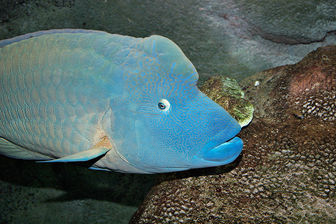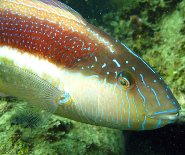Maori wrasse

The Maori wrasse lives in the benthopelagic, marine, depth range 60 - m environment.
The Maori Wrasse - A Colorful, Inquisitive Tropical Fish
 The Maori wrasse (Ophthalmolepis lineolata) is an oceanic fish that inhabits the coral reefs, rocky coasts and sandy, weedy bays off eastern and southern Australia. It also thrives in New Zealand waters, notably in Nelson Bay. The Maori wrasse is noted for its striking colors and "friendliness" toward humans, which some believe could lead to ecological complications.
The Maori wrasse (Ophthalmolepis lineolata) is an oceanic fish that inhabits the coral reefs, rocky coasts and sandy, weedy bays off eastern and southern Australia. It also thrives in New Zealand waters, notably in Nelson Bay. The Maori wrasse is noted for its striking colors and "friendliness" toward humans, which some believe could lead to ecological complications.
Colors change with age. Females and young fish are reddish-orange or crimson, fading in color intensity on the underside. Males, which are larger, feature side stripes and blue markings about the body and head. These markings remind of the tattoos common among the Maori culture of New Zealand, hence the name.
More than 400 species of wrasses have been identified in the world's oceans. Most swim tropical and temperate waters. They generally prefer relatively shallow coral and rocky environs, although in cooler waters, Maori wrasses may be found at depths of 60 meters (197 feet).
The fish grow as long as 47 centimeters (18 inches) and weigh as much as .9 kilograms (2 pounds). They are not at all skittish. Divers easily can approach closely and take pictures. In fact, Maori wrasses often follow swimmers and divers through the water. It has been suggested Maori wrasses are as curious about humans as humans are about them.
The classification "Maori wrasse" has been applied to numerous fish, and Ophthalmolepis lineolata has been confused with similar species. For example, the Humphead wrasse (Cheilinus undulatus) also has been dubbed "Maori wrasse." The Humphead is the largest species in the wrasse group. Ophthalmolepis lineolata may be distinguished as the "southern" Maori wrasse. It has been called the Maori parrotfish, Australian Maori wrasse, Rainbow-fish and simply Maori - but some of those names, too, have been confused.
Wrasses have sharp front teeth and crushing molars along the throat, employed to fragment prey. Wrasses eat mollusks, crustaceans and other invertebrates of different sizes. The Maori wrasse feeds on benthic (ocean floor) invertebrates. Wrasses are the victims, in turn, of larger predator fish such as sharks, barracudas and eels.
Maori wrasses regularly are brought up as a by-catch by coastal net fishers. In some areas, regulations prohibit commercial use; regulations vary by wrasse species. The Maori wrasse is used a bait fish and is exported as an aquarium fish. Certain other species of wrasses are considered edible delicacies.
While not endangered presently, Maori wrasses face long-term threats resulting from reef deterioration.
Picture of the Maori wrasse by Richard Ling from NSW, Australia, licensed under the Creative Commons Attribution-Share Alike 2.0 Generic license.
Common names
Australian maori-wrasse in English
Butcher's prick in English
maori in English
Maori parrotfish in English
Maori wrasse in English
Rainbow-fish in English
Southern maori wrasse in English
白条毛利隆头鱼 in Mandarin Chinese
白條毛利隆頭魚 in Mandarin Chinese

Family : Labridae
Genus : Ophthalmolepis
Species : Ophthalmolepis lineolata
Authority : Valenciennes, 1839
